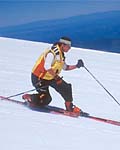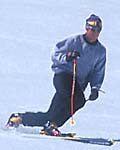|
|
| ||||||||||||||||||||||||||||||
|
Racing Camp for Non-Racers Getting Over the Skids [TELEMARK CAMP INFO] 17 JUL 2000 I fully respect the hard-earned glory of the great ski racers. All that training time on the course keeps the population down in the backcountry.
I am not a racer. Lapping the same run, over and over again, when you could be touring in the woods or hiking for turns, never seemed that interesting to me.
But when I heard about a telemark race camp at Timberline Lodge and Ski Resort, organized by the United States Telemark Ski Association (USTSA) on the south side of breathtaking Mt. Hood, my initial thoughts were, summer skiing? Sure. Corn snow? Yep. Improve my turns? We'll see.
Many of the best known pro skiers grew up racing, and if there's one thing it gave them, it's honed, aggressive, precise ability.
Plus, current World Cup Telemark Champion Reid Sabin is from Whitefish, Montana, and if that's not down home, I don't know what is.
So, though racing seemed boring to me before, I figured I'd give it a try. What's the worst thing that could happen, other than having to wear a funny tight suit?
I made arrangements to meet up with other members of the camp, including organizers and instructors Jimmy Ludlow and Grayson Davis, at Trillium Lake. It's the closest campground to Timberline, by Government Camp, Oregon, on the south side of Hood. Camping was definitely within my budget range. I was a little nervous about not having a cute race suit, but I'm recently engaged, so who cares.
We spent most of the first day freeskiing. I could handle that. The main focus was to keep our bodies facing down the hill. The second day, Jimmy set up gates, and we practiced side-slipping through imaginary couloirs the width of our skis (imagination is key, keeps things interesting, it was an extremely tight couloir). Sounds easy enough, but when you actually slip down with slow, deliberate movements, you notice the subtle effects of balance that can help, or hinder, your skiing.
By the time camp was over at 1pm, the halfpipe was just starting to look good, so I headed over to with fellow tele race camper Adam U, and my snowboarding buddy Lucas. At the pipes on the Palmer Glacier, there's no pressure, no vibes, just riding. Timberline has very low-key halfpipes, making it a great place to learn. A number of summer snowboard camps reserve terrain parks on the glacier (and alpine ski-racing camps have their own private lanes), but the public pipe was practically empty when we went by, so we hung around for a few laps.
After a little extracurricular fun in the halfpipe, skiing was over for the day, and it was only 3pm. When we got back to Trillium Lake, we had to make the difficult decision whether to go mountain biking, climbing or canoeing on the lake. Our counselors considered these activities dry land training. I could handle that. US telemark team member Lori Stahler headed out on a mountain bike ride with Grayson. Some of us opted for a few hours of climbing at the local crag (be nice to camp host Sean and maybe he'll show you the way), while others stayed at camp to drink beer.
The second day of clinics on the glacier was more of the same drills, but as we'd soon find out, Jimmy and Grayson had plans to get us carving. As we did more drills, which at the time seemed rather tedious (except for the jokes about hip movements that we couldn't seem to drop), I started to get it.
I started to notice the intermediate plateau I was stuck at and why. I also began to grasp what needed to happen if I was ever going get better. Sure, many intermediate-level, recreational telemark skiers can ski down most types of terrain on pins, but it doesn't always look pretty. You can drop the knee, switch the feet, but the subtle difference between skidding out of the turn and carving it out is the brick wall for many people.
There is a huge difference between carving a telemark turn, and being stuck in the intermediate rut that causes many recreational telemarkers to plateau, which is switch, skid, switch, skid, switch, skid.
By day three, I was really getting psyched about hitting the course. I crawled out of my tent, nursed my hangover with some coffee and made it to the lift in 20 minutes.
This would be the first day of taking what we had learned and making it happen.
The drills included mono-mark turns, like tele turns, but without the usual lead change (putting one ski forward). So picture yourself in a telemark stance, but making turns left and right, without changing your lead ski. It's the only drill that really made me feel the edges on my skis, which is important, because that's the only way you can turn. Sounds impossible, I know, but it works.
So, the theme of the day was edging and making the sidecut of your ski work for you. The light bulb came on when I actually was able to turn left, right and left, without making a lead change, and in a telemark stance. We then headed back to the gates. Where we reinforced that feeling of your skis steering you around, by running the gates, making medium sized turns and adding the lead change. By this time, I was loving the gates.
Beyond the Gate Bashing
During a lunch break at the beautiful and historic Silcox Hut, located at the 7,000-foot level, a couple of us met up with the organizers of another telemark camp. I had seen this group skiing together and heard they went touring each afternoon (with the required wilderness permits). They invited a few of us to join their group for some exploring.
Be warned, summer skiing at Mt. Hood is outstanding, but if you're outside the boundaries and don't know where you're going, it's easy to get lost. Go with a guide, or know where you're going, because as is true with most volcanoes in the Northwest, a small diversion higher on the mountain could send you into a totally different valley lower down, leaving you with hours of slogging to make your way out, or worse, not enough time to get back before dark.
Needless to say, these Mt. Hood veterans showed us the way.
Lori and I were really psyched to check out the area on the glacier west of the lifts. As we suspected, the snow was incredible, and the group showed us a steep gully that we hiked twice for some great turns. Lori looked awesome, as always, and I felt like I was skiing better than when I arrived.
"What camp are you guys in?" said one of the other campers.
Lori told them we were in the racing camp.
Then he looked at me.
"Uh, well, no, I'm not a racer... just trying to improve," I said.
"Racing camp? When's the next one?" he asked.
Oh, God, I immediately felt a little guilty for potentially stealing campers from the folks who were nice enough to let us poach their outing. But to their credit, these guys were exploring in the afternoons, so I take the Switzerland stance and recommend both camps. But even with a some great touring under our belts, I couldn't wait to hit the gates again the next day.
The fourth day of camp was the epiphany. We took everything we learned— all the drills that isolated those subtle sensations of balance and edging— and just had fun reinforcing the free-heel flow.
I'm looking forward to signing up every summer for sweet turns on Mt. Hood. And next time I start to feel like racing is too structured, I'll just pretend the gates are trees.
— Michelle Quigley, MountainZone.com Staff
MORE FRESH TRACKS: Go there
|
|
||||||||||||||||||||||||||||


